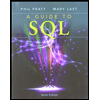
a.
Trigger:
The trigger is a named set of SQL statement that is executed at the time of data modification or meets some data description.
- If the stated trigger condition meets up, then the mentioned action in the trigger has been performed.
There are three parts of trigger; they are:
Event:
- It specifies the change to be made, such as an UPDATE or DELETE of a record.
Condition:
- It specifies the condition to examine the records about to be affected. For each record, that meets the condition given in the trigger.
Action:
- The action performed after the start of the trigger.
The syntax to create a trigger is as given below:
CREATE TRIGGER trigger_name
{BEFORE| AFTER|INSTEAD OF} {INSERT|DELETE|UPDATE} ON
table_name
[FOR EACH{ROW|STATEMENT}] [WHEN(condition)]
<triggered SQL statement here>;
Explanation of Solution
b.
Query to create trigger:
CREATE OR REPLACE TRIGGER UPD_CUSTOMER
AFTER UPDATE ON CUSTOMER FOR EACH ROW
BEGIN
UPDATE REP
SET COMMISSION = COMMISSION + ((:NEW.BALANCE - :OLD.BALANCE)*RATE);
END;
Explanation:
- The above query is used to create a trigger named “UPD_CUSTOMER” to update the “COMMISSION” contents in the “REP” table whenever a record is inserted in the “CUSTOMER” table...
Explanation of Solution
c.
Query to create trigger:
CREATE OR REPLACE TRIGGER DEL_CUSTOMER
AFTER DELETE ON CUSTOMER FOR EACH ROW
BEGIN
UPDATE REP
SET COMMISSION = COMMISSION - (:OLD.BALANCE * RATE);
END;
Explanation:
- The above query is used to create a trigger named “DEL_CUSTOMER” to update the “COMMISSION” contents in the “REP” table whenever a record is delete in the “CUSTOMER” table...
Trending nowThis is a popular solution!

Chapter 8 Solutions
A GUIDE TO SQL
- Pllleasassseee ssiiirrrr soolveee thissssss questionnnnnnnarrow_forward4. def modify_data(x, my_list): X = X + 1 my_list.append(x) print(f"Inside the function: x = {x}, my_list = {my_list}") num = 5 numbers = [1, 2, 3] modify_data(num, numbers) print(f"Outside the function: num = {num}, my_list = {numbers}") Classe Classe that lin Thus, A pro is ref inter Ever dict The The output: Inside the function:? Outside the function:?arrow_forwardpython Tasks 5 • Task 1: Building a Library Management system. Write a Book class and a function to filter books by publication year. • Task 2: Create a Person class with name and age attributes, and calculate the average age of a list of people Task 3: Building a Movie Collection system. Each movie has a title, a genre, and a rating. Write a function to filter movies based on a minimum rating. ⚫ Task 4: Find Young Animals. Create an Animal class with name, species, and age attributes, and track the animals' ages to know which ones are still young. • Task 5(homework): In a store's inventory system, you want to apply discounts to products and filter those with prices above a specified amount. 27/04/1446arrow_forward
- Of the five primary components of an information system (hardware, software, data, people, process), which do you think is the most important to the success of a business organization? Part A - Define each primary component of the information system. Part B - Include your perspective on why your selection is most important. Part C - Provide an example from your personal experience to support your answer.arrow_forwardManagement Information Systemsarrow_forwardQ2/find the transfer function C/R for the system shown in the figure Re དarrow_forward
- Please original work select a topic related to architectures or infrastructures (Data Lakehouse Architecture). Discussing how you would implement your chosen topic in a data warehouse project Please cite in text references and add weblinksarrow_forwardPlease original work What topic would be related to architectures or infrastructures. How you would implement your chosen topic in a data warehouse project. Please cite in text references and add weblinksarrow_forwardWhat is cloud computing and why do we use it? Give one of your friends with your answer.arrow_forward
- What are triggers and how do you invoke them on demand? Give one reference with your answer.arrow_forwardDiscuss with appropriate examples the types of relationships in a database. Give one reference with your answer.arrow_forwardDetermine the velocity error constant (k,) for the system shown. + R(s)- K G(s) where: K=1.6 A(s+B) G(s) = as²+bs C(s) where: A 14, B =3, a =6. and b =10arrow_forward
 A Guide to SQLComputer ScienceISBN:9781111527273Author:Philip J. PrattPublisher:Course Technology Ptr
A Guide to SQLComputer ScienceISBN:9781111527273Author:Philip J. PrattPublisher:Course Technology Ptr Database Systems: Design, Implementation, & Manag...Computer ScienceISBN:9781285196145Author:Steven, Steven Morris, Carlos Coronel, Carlos, Coronel, Carlos; Morris, Carlos Coronel and Steven Morris, Carlos Coronel; Steven Morris, Steven Morris; Carlos CoronelPublisher:Cengage Learning
Database Systems: Design, Implementation, & Manag...Computer ScienceISBN:9781285196145Author:Steven, Steven Morris, Carlos Coronel, Carlos, Coronel, Carlos; Morris, Carlos Coronel and Steven Morris, Carlos Coronel; Steven Morris, Steven Morris; Carlos CoronelPublisher:Cengage Learning
 Database Systems: Design, Implementation, & Manag...Computer ScienceISBN:9781305627482Author:Carlos Coronel, Steven MorrisPublisher:Cengage Learning
Database Systems: Design, Implementation, & Manag...Computer ScienceISBN:9781305627482Author:Carlos Coronel, Steven MorrisPublisher:Cengage Learning Programming with Microsoft Visual Basic 2017Computer ScienceISBN:9781337102124Author:Diane ZakPublisher:Cengage Learning
Programming with Microsoft Visual Basic 2017Computer ScienceISBN:9781337102124Author:Diane ZakPublisher:Cengage Learning




